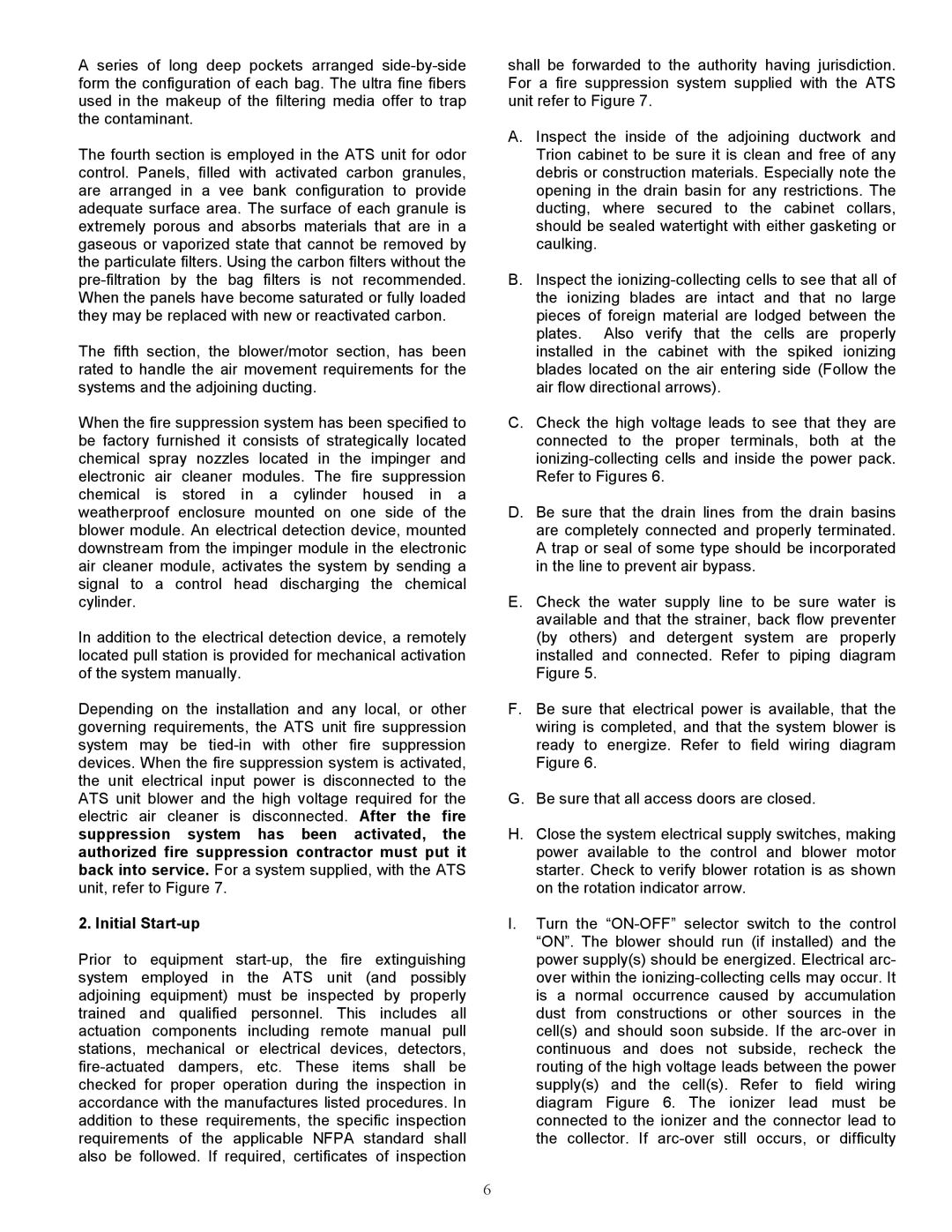Aseries of long deep pockets arranged side-by-side form the configuration of each bag. The ultra fine fibers used in the makeup of the filtering media offer to trap the contaminant.
The fourth section is employed in the ATS unit for odor control. Panels, filled with activated carbon granules, are arranged in a vee bank configuration to provide adequate surface area. The surface of each granule is extremely porous and absorbs materials that are in a gaseous or vaporized state that cannot be removed by the particulate filters. Using the carbon filters without the pre-filtration by the bag filters is not recommended. When the panels have become saturated or fully loaded they may be replaced with new or reactivated carbon.
The fifth section, the blower/motor section, has been rated to handle the air movement requirements for the systems and the adjoining ducting.
When the fire suppression system has been specified to be factory furnished it consists of strategically located chemical spray nozzles located in the impinger and electronic air cleaner modules. The fire suppression chemical is stored in a cylinder housed in a weatherproof enclosure mounted on one side of the blower module. An electrical detection device, mounted downstream from the impinger module in the electronic air cleaner module, activates the system by sending a signal to a control head discharging the chemical cylinder.
In addition to the electrical detection device, a remotely located pull station is provided for mechanical activation of the system manually.
Depending on the installation and any local, or other governing requirements, the ATS unit fire suppression system may be tied-in with other fire suppression devices. When the fire suppression system is activated, the unit electrical input power is disconnected to the ATS unit blower and the high voltage required for the electric air cleaner is disconnected. After the fire suppression system has been activated, the authorized fire suppression contractor must put it back into service. For a system supplied, with the ATS unit, refer to Figure 7.
2. Initial Start-up
Prior to equipment start-up, the fire extinguishing system employed in the ATS unit (and possibly adjoining equipment) must be inspected by properly trained and qualified personnel. This includes all actuation components including remote manual pull stations, mechanical or electrical devices, detectors, fire-actuated dampers, etc. These items shall be checked for proper operation during the inspection in accordance with the manufactures listed procedures. In addition to these requirements, the specific inspection requirements of the applicable NFPA standard shall also be followed. If required, certificates of inspection
shall be forwarded to the authority having jurisdiction. For a fire suppression system supplied with the ATS unit refer to Figure 7.
A.Inspect the inside of the adjoining ductwork and Trion cabinet to be sure it is clean and free of any debris or construction materials. Especially note the opening in the drain basin for any restrictions. The ducting, where secured to the cabinet collars, should be sealed watertight with either gasketing or caulking.
B.Inspect the ionizing-collecting cells to see that all of the ionizing blades are intact and that no large pieces of foreign material are lodged between the plates. Also verify that the cells are properly installed in the cabinet with the spiked ionizing blades located on the air entering side (Follow the air flow directional arrows).
C.Check the high voltage leads to see that they are connected to the proper terminals, both at the ionizing-collecting cells and inside the power pack. Refer to Figures 6.
D.Be sure that the drain lines from the drain basins are completely connected and properly terminated. A trap or seal of some type should be incorporated in the line to prevent air bypass.
E.Check the water supply line to be sure water is available and that the strainer, back flow preventer (by others) and detergent system are properly installed and connected. Refer to piping diagram Figure 5.
F.Be sure that electrical power is available, that the wiring is completed, and that the system blower is ready to energize. Refer to field wiring diagram Figure 6.
G.Be sure that all access doors are closed.
H.Close the system electrical supply switches, making power available to the control and blower motor starter. Check to verify blower rotation is as shown on the rotation indicator arrow.
I.Turn the “ON-OFF” selector switch to the control “ON”. The blower should run (if installed) and the power supply(s) should be energized. Electrical arc- over within the ionizing-collecting cells may occur. It is a normal occurrence caused by accumulation dust from constructions or other sources in the cell(s) and should soon subside. If the arc-over in continuous and does not subside, recheck the routing of the high voltage leads between the power supply(s) and the cell(s). Refer to field wiring diagram Figure 6. The ionizer lead must be connected to the ionizer and the connector lead to the collector. If arc-over still occurs, or difficulty
